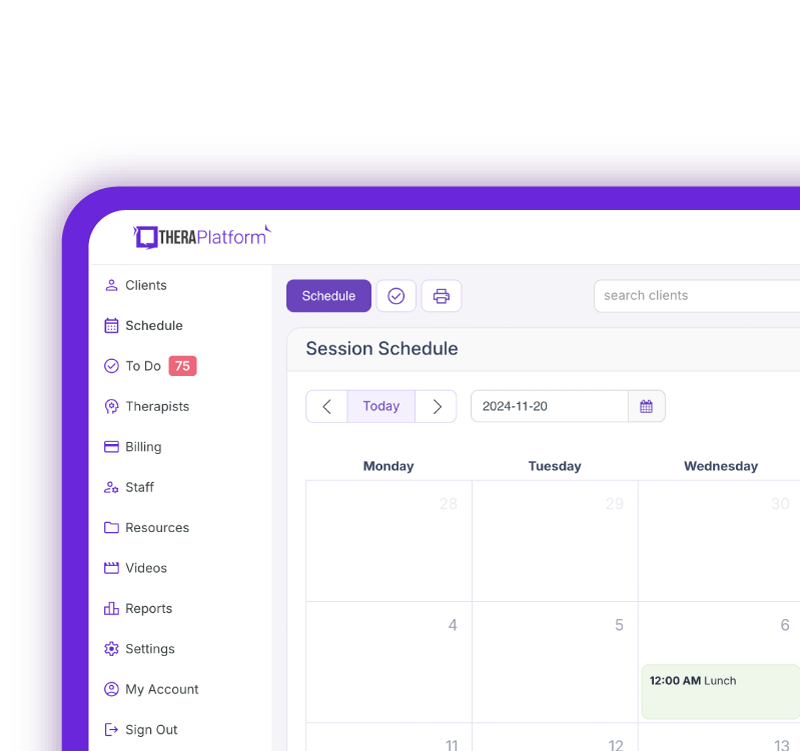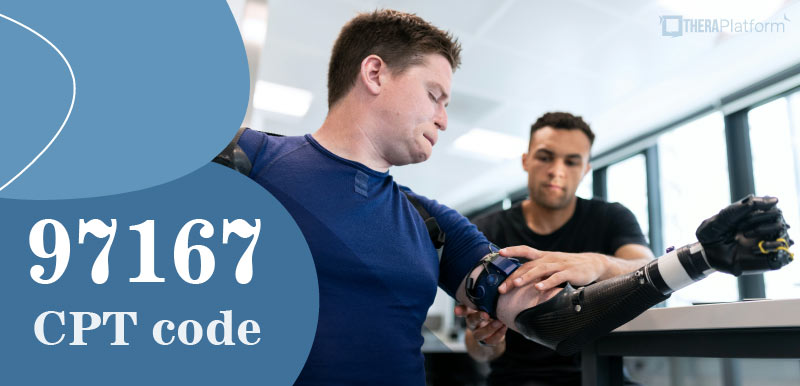CPT for ultrasound

97035 CPT code is used to describe ultrasound – a modality used both diagnostically and therapeutically by physical therapists. Diagnostic ultrasound is the practice of using ultrasound waves to visualize body tissues to identify or diagnose a medical condition such as a torn ligament or an inflamed tendon.
Summary
- The 97035 CPT code is used to bill for therapeutic ultrasound, a modality in physical therapy that promotes tissue healing and reduces inflammation.
- Common conditions benefiting from therapeutic ultrasound include tendonitis, bursitis, ligament sprains, frozen shoulder, muscle strains, and muscle tears.
- To bill for therapeutic ultrasound, physical therapists must follow Medicare's 8-minute rule, ensure 1:1 direct patient contact, avoid concurrent billing with electrical stimulation, and provide detailed documentation. Enrolling in an insurance billing course for therapists can help providers enhance their knowledge.
- Using EHR systems like TheraPlatform with integrated billing software can automate claim submissions, track payments, reduce errors, and streamline the insurance billing process for physical therapists.
→ Enroll in My Free, On-Demand Insurance Billing for Therapists Course
Therapeutic ultrasound is a treatment modality utilized to increase the rate of tissue healing and to improve the quality of tissue repair. Extra therapist training is required to implement diagnostic ultrasound in your practice, however, therapeutic ultrasound is part of the physical therapy school curriculum.
In this article, we will review the mechanisms and indications of therapeutic ultrasound, touch on the importance of staying up-to-date with best practices and describe how to utilize the 97035 CPT code for therapeutic ultrasound.
Streamline your insurance billing with One EHR
- Claim batching
- Auto claims
- Automated EOB & ERA
- Real-time claim validation
- Real-time claim tracking
- Aging and other reports

Therapeutic ultrasound 101
Therapeutic ultrasound is a treatment modality found in many physical therapy clinics. It is used to promote tissue healing and treat chronic inflammation. Ultrasound is administered via a handheld transducer which is moved across the skin of the target area.
When the ultrasound transducer moves across the skin, sound waves pass into the underlying tissues where they are absorbed and attenuated by those tissues. The frequency of the sound waves dictates the depth at which ultrasound waves are absorbed while the composition of the underlying tissues affects wave attenuation and absorption levels.
Physical therapists use 1MHz and 3MHz ultrasound frequencies as well as pulsed and continuous forms of ultrasound. Ultrasound gels and creams help direct more sound waves into the target tissues rather than into the surrounding air.
Therapeutic ultrasound can produce both thermal and nonthermal effects and while both effects are probably happening simultaneously to some degree, you can select which effect predominates during your treatment.
Watch this video to learn common insurance billing struggles and solutions
→ Start My Free Trial
→ Start My Free Trial
Nonthermal effects occur via stable cavitation and acoustic streaming which are thought to excite the tissue cell membrane leading to an upregulation in cell activity. This upregulation is believed to play a role in tissue healing. Thermal effects of ultrasound include increased blood flow to underlying tissues via their warming which may help resolve chronic states of inflammation.
Physical therapists use ultrasound to accelerate tissue and healing and reduce inflammation.
Examples of conditions that may benefit from the application of therapeutic ultrasound are listed below:
- Tendonitis
- Achilles tendonitis
- Medial and lateral epicondylitis
- Bicipital tendinopathy
- Bursitis
- Ligament sprains or tears
- Frozen shoulder
- Muscle strains
- Muscle tears
97035 CPT code: Billing for therapeutic ultrasound services
Whether you are a novice or an experienced physical therapist, you are probably accustomed to selecting and reporting CPT codes as part of the billing process. At this point you can probably perform this task with your eyes closed but have you ever given any thought as to why these codes exist in the first place?
The term CPT stands for Current Procedural Terminology. These codes were developed to provide a uniform language of coding for medical services and procedures that can be used across all medical providers. As physical therapists, you utilize CPT codes to describe the services rendered during a patient encounter. Codes are then submitted via a claim to a third-party payer who will use this information to approve or deny payment for said claim.
All CPT codes are five digits and are either numeric or alphanumeric. In general, most of the codes used by physical therapists fall under the 97000 series called Physical Medicine and Rehabilitation, however, a PT can use any CPT code as long as the service described falls under the physical therapy scope of practice defined by your state licensure laws. Some of the 97000 codes commonly utilized by physical therapists include:
CPT Code | Condition |
|---|---|
Manual Therapy | |
Therapeutic Exercise | |
Therapeutic Activity | |
Neuromuscular Re-education | |
Gait Training | |
Low Complexity Evaluation | |
97035 | Therapeutic Ultrasound, constant attendance |
Billing for therapeutic ultrasound using the 97035 CPT code is not as simple as it may sound. The Centers for Medicare and Medicaid Services (CMS) require that several criteria be met prior to submitting this code for reimbursement. Below we will outline those requirements.
8-minute rule: Therapeutic ultrasound is administered in 15-minute increments and follows the 8-minute rule. This means that in order to bill for one unit of therapeutic ultrasound you must administer it for at least 8 minutes and no more than 22 minutes. To bill two units of ultrasound you must administer it for 23 to 37 minutes. Only two units of ultrasound per day per discipline will be covered. Additional units will be denied.
→ Download My Free 8-minute Rule Therapy Chart
1:1 Direct contact: Coverage for therapeutic ultrasound is only provided for the time in which the therapist is performing the procedure and is in direct contact with the patient. This means non-supervised ultrasound is not covered nor is supervised ultrasound performed while the therapist is also treating another patient.
Concurrent ultrasound + electrical stimulation: Do not bill for both ultrasound and electrical stimulation administered at the same time. Instead, this service should be billed as ultrasound.
Phonophoresis: Phonophoresis in the form of ultrasound used to enhance topical drug delivery should be billed using the 97035 CPT code. A separate payment will not be made for the drugs utilized in the procedure.
Supportive documentation: Supportive documentation for the ongoing use of ultrasound is required at least every 10 visits for 97035 CPT code. This ensures the standard of medical necessity is regularly re-evaluated. Additionally, you must carefully document the need for ongoing ultrasound if you plan to provide more than twelve treatments.
During your documentation be sure to report the following information:
- Area(s) being treated
- The frequency and intensity of the ultrasound administered
- Objective clinical findings that support the need for ongoing ultrasound (example: range of motion measurements)
- Subjective clinical findings that support the need for ongoing ultrasound (example: pain ratings, pain location, functional limitations)
Note, that if neither a subjective or objective clinical improvement is observed after six ultrasound treatments, you should implement a change in the treatment plan. If you believe your patient would benefit from continued ultrasound treatment, however, be sure to thoroughly document this need and provide support for why it is clinically necessary.
Practice Management + EHR + Telehealth
Mange more in less time in your practice with TheraPlatform

.
Continuing training
The use of modalities within the practice of physical therapy continues to be researched and debated. At this time physical therapy students learn how to safely prescribe and administer therapeutic ultrasound during their schooling but therapists who have been practicing for a while may feel out of practice.
Like all modalities, therapeutic ultrasound has the ability to heal and harm. Many patients such as those with diminished sensation or pacemakers, patients with active cancer and pregnant patients as well as those with many other medical conditions may be inappropriate for therapeutic ultrasound.
You must review indications, contraindications, parameters and procedures before administering this modality. Reviewing an up-to-date modalities textbook or searching for a continuing education course are two ways to refresh your training on therapeutic ultrasound.
When it comes to expanding your box of physical therapy tools, ultrasound may be a handy addition. With proper training and review of safe practices as well as an understanding of how to prepare supportive documentation, you can both enhance your patient’s care and increase your confidence that your hard work and services will be reimbursed by insurance.
How EHR and practice management software can save you time with insurance billing for therapists
EHRs with integrated billing software and clearing houses, such as TheraPlatform, offer therapists significant advantages in creating an efficient insurance billing process. The key is minimizing the amount of time dedicated to developing, sending, and tracking medical claims through features such as automation and batching.
What are automation and batching?
- Automation refers to setting up software to perform tasks with limited human interaction.
- Batching or performing administrative tasks in blocks of time at once allows you to perform a task from a single entry point with less clicking.
Which billing and medical claim tasks can be automated and batched through billing software?
- Invoices: Create multiple invoices for multiple clients with a click or two of a button or set up auto-invoice creation, and the software will automatically create invoices for you at the preferred time. You can even have the system automatically send invoices to your clients.
- Credit card processing: Charge multiple clients with a click of a button or set up auto credit card billing, and the billing software will automatically charge the card (easier than swiping!)
- Email payment reminders: Never manually send another reminder email for payment again, or skip this altogether by enabling auto credit card charges.
- Automated claim creation and submission: Batch multiple claims with one button click or turn auto claim creation and submission on.
- Live claim validation: The system reviews each claim to catch any human errors before submission, saving you time and reducing rejected claims.
- Automated payment posting: Streamline posting procedures for paid medical claims with ERA. When insurance offers ERA, all their payments will post automatically on TheraPlatform's EHR.
- Tracking: Track payment and profits, including aging invoices, overdue invoices, transactions, billed services, service providers
Utilizing billing software integrated with an EHR and practice management software can make storing and sharing billing and insurance easy and save providers time when it comes to insurance billing for therapists.
Streamline your practice with One EHR
- Scheduling
- Flexible notes
- Template library
- Billing & payments
- Insurance claims
- Client portal
- Telehealth
- E-fax

Resources
TheraPlatform is an all-in-one EHR, practice management, and teletherapy software built for therapists to help them save time on admin tasks. It offers a 30-day risk-free trial with no credit card required and supports different industries and sizes of practices, including physical therapists in group and solo practices.
More resources
- Therapy resources and worksheets
- Therapy private practice courses
- Ultimate teletherapy ebook
- The Ultimate Insurance Billing Guide for Therapists
- The Ultimate Guide to Starting a Private Therapy Practice
- Insurance billing 101
- Practice management tools
Free video classes
- Free on-demand insurance billing for therapist course
- Free mini video lessons to enhance your private practice
- 9 Admin tasks to automate in your private practice
References
Article - Billing and Coding: Outpatient Physical and Occupational Therapy Services (A56566). (n.d.). https://www.cms.gov, https://www.cms.gov/medicare-coverage-database/view/article.aspx?articleId=56566



